- Home
- J. M. Barrie
Peter Pan (Barnes & Noble Classics Series)
Peter Pan (Barnes & Noble Classics Series) Read online
Table of Contents
FROM THE PAGES OF PETER PAN
Title Page
Copyright Page
J. M. BARRIE
THE WORLD OF J. M. BARRIE AND PETER PAN
Introduction
CHAPTER I - Peter Breaks Through
CHAPTER II - The Shadow
CHAPTER III - Come Away, Come Away!
CHAPTER IV - The Flight
CHAPTER V - The Island Come True
CHAPTER VI - The Little House
CHAPTER VII - The Home under the Ground
CHAPTER VIII - The Mermaids’ Lagoon
CHAPTER IX - The Never Bird
CHAPTER X - The Happy Home
CHAPTER XI - Wendy’s Story
CHAPTER XII - The Children Are Carried Off
CHAPTER XIII - Do You Believe in Fairies?
CHAPTER XIV - The Pirate Ship
CHAPTER XV - “Hook or Me This Time”
CHAPTER XVI
CHAPTER XVII - When Wendy Grew Up
ENDNOTES
INSPIRED BY PETER PAN
COMMENTS & QUESTIONS
FOR FURTHER READING
FROM THE PAGES OF PETER PAN
All children, except one, grow up.
(page 7)
“You see, children know such a lot now, they soon don’t believe in fairies, and every time a child says, ‘I don’t believe in fairies,’ there is a fairy somewhere that falls down dead.”
(page 29)
“Wake up,” she cried, “Peter Pan has come and he is to teach us to fly.”
(page 32)
In the midst of them, the blackest and largest jewel in that dark setting, reclined James Hook, or as he wrote himself, Jas. Hook, of whom it is said he was the only man that the Sea-Cook feared. He lay at his ease in a rough chariot drawn and propelled by his men, and instead of a right hand he had the iron hook with which ever and anon he encouraged them to increase their pace.
(page 52)
“I want their captain, Peter Pan. ’Twas he cut off my arm.” He brandished the hook threateningly. “I’ve waited long to shake his hand with this. Oh, I’ll tear him!”
(page 56)
Then all went on their knees, and holding out their arms cried, “0 Wendy lady, be our mother.”
(page 68)
“If you believe,” he shouted to them, “clap your hands; don’t let Tink die.”
(page 118)
Then he sought to close and give the quietus with his iron hook, which all this time had been pawing the air; but Peter doubled under it and, lunging fiercely, pierced him in the ribs. At sight of his own blood, whose peculiar colour, you remember, was offensive to him, the sword fell from Hook’s hand, and he was at Peter’s mercy.
(page 135)
“The last thing he ever said to me was, ‘Just always be waiting for me, and then some night you will hear me crowing.’”
(page 154)
Published by Barnes & Noble Books
122 Fifth Avenue
New York, NY 10011
www.barnesandnoble.com/classics
Peter Pan was first published as Peter and Wendy in 1911.
Published in 2005 by Barnes & Noble Classics with new Introduction, Notes,
Biography, Chronology, Inspired By,
Comments & Questions, and For Further Reading.
Introduction, Notes, and For Further Reading
Copyright © 2005 by Amy Billone.
Note on J. M. Barrie, The World of J. M. Barrie and Peter Pan,
Inspired by Peter Pan, and Comments & Questions
Copyright © 2005 by Barnes & Noble, Inc.
All rights reserved. No part of this publication may be reproduced
or transmitted in any form or by any means, electronic or mechanical, including
photocopy, recording, or any information storage and retrieval system,
without the prior written permission of the publisher.
Barnes & Noble Classics and the Barnes & Noble Classics
colophon are trademarks of Barnes & Noble, Inc.
Peter Pan
ISBN-13: 978-1-59308-213-0 ISBN-10: 1-59308-213-4
eISBN : 978-1-411-43289-5
LC Control Number 2005923984
Produced and published in conjunction with:
Fine Creative Media, Inc.
322 Eighth Avenue
New York, NY 10001
Michael J. Fine, President and Publisher
Printed in the United States of America
QM
3 5 7 9 10 8 6 4 2
J. M. BARRIE
James Matthew Barrie was born on May 9, 1860, in Kirriemuir, Scotland, the ninth child and third and youngest son of David Barrie, a handloom weaver, and Margaret Ogilvy, who, following Scottish tradition, kept her maiden name among friends and family. In January 1867, when Barrie was six years old, his older brother David died in a skating accident on the eve of his fourteenth birthday, an event that haunted Barrie for the rest of his life.
Barrie’s love of the theater bloomed at Dumfries Academy, which he attended for five years, beginning at age thirteen. He earned his master of arts degree in English literature from Edinburgh University in 1882. The next year he became leader-writer and sub-editor for the Nottingham Journal. In 1885 he moved to London, where he worked as a free-lance journalist; he self-published his first novel, Better Dead, two years later. With his second book, a collection of sketches titled Auld Licht Idylls (1888), he achieved recognition as a writer, and his reputation increased with the publication the same year of the novel When a Man’s Single. In 1889 his A Window in Thrums appeared, and in 1891 he published the popular novel The Little Minister.
Barrie had his first commercial theatrical success with Walker, London (1892). Two years later he married Mary Ansell, an actress who had performed one of the play’s leading roles. In 1896 two of Barrie’s works were published: the novel Sentimental Tommy (its sequel, Tommy and Grizel, appeared in 1900), and Margaret Ogilvy, a memoir of his mother. Barrie first met George and Sylvia Llewelyn Davies and their sons George and Jack in 1897. The author’s play-acting with the boys was the principal source of material for his play Peter Pan; or, The Boy Who Would Not Grow Up.
Barrie’s 1902 novel The Little White Bird contains an early version of Peter Pan and describes Peter’s life as a baby. Over the course of the next nine years, Barrie refined Peter Pan in various stage productions and publications. The play version of the story opened at the Duke of York’s Theatre on December 27,1904. Two years later, Barrie extracted six chapters from The Little White Bird that he published as Peter Pan in Kensington Gardens, and in 1911 he published the novel Peter and Wendy; longer than Peter Pan in Kensington Gardens, this book is now known simply as Peter Pan.
Barrie and his wife divorced in 1909. He never remarried, but the next year he acquired a family when Sylvia, the mother of the Llewelyn Davies boys, died (her husband had died in 1907) and Barrie adopted her sons (there were now five boys). In 1915 George, the oldest boy, was killed in World War I during an advance on the Germans. The same year Charles Frohman, Barrie’s producer, went down on the passenger ship the Lusitania when a German torpedo hit it. Nevertheless, the next six years were fairly productive for Barrie as a writer and happy for him as a father, until Michael, the fourth of the brothers, drowned while swimming in a millpond with a friend. Barrie never recovered from Michael’s death, which effectively brought his creative output to a halt.
In addition to the play Peter Pan, Barrie had a string of hits in the theater: the theatrical version of The Little Minister (1897), Quality Street and The Admirable Crichton (both 1902), and What Every Woma
n Knows (1908). A Kiss for Cinderella opened in 1916 and was often revived in London around Christmastime. Two fantasy plays followed: In Dear Brutus (1917), a group of people encounter their alternate destinies when they enter a magic forest, and in Mary Rose (1920), a woman dies young and returns to her family years later as a ghost, unable to recognize her now aged son. Barrie’s last play, The Boy David, opened in 1936 and was not successful. On June 19, 1937, J. M. Barrie died. He was buried with his family in Kirriemuir cemetery.
THE WORLD OF J. M. BARRIE AND PETER PAN
1860 James Matthew Barrie is born on May 9 in Kirriemuir, Scotland. The third son of seven surviving children, James shares two rooms with his entire family. The cottage also houses the handlooming tools with which his father, David, earns a living. The countryside surrounding Kirriemuir features breathtaking glens and stark mountains, and lush vegetation, lochs, and castles abound; the setting will influence Barrie’s later writings.
1865 Lewis CarroUs Alice’s Adventures in Wonderland is published.
1867 Barrie’s brother David is killed in a skating accident. Margaret Ogilvy, Barrie’s mother, never recovers from the loss of her second son, and the death will haunt James for the rest of his life.
1868 James leaves home to live with his brother Alexander and attend Glasgow Academy, where Alexander teaches classics.
1871 When Alexander leaves Glasgow, James moves with the rest of the family to the town of Forfar, where he enrolls in Forfar Academy. Lewis Carroll’s Through the Looking Glass and What Alice Found There is published.
1872 George Eliot’s Middlemarch is published.
1873 James again moves in with his brother to attend Dumfries Academy in Dumfries, in southwestern Scotland; Alexander is the inspector of schools for the district. James will study at the academy for five years. Jules Verne’s Around the World in Eighty Days is published.
1878 Barrie enters Edinburgh University, supported financially by Alexander, who lectures there. While a student he becomes a part-time professional journalist, reviewing literature for the Edinburgh Courant and music for the Dumfries Herald.
1879 Henrik Ibsen’s A Doll’s House premieres.
1982 arrie receives his master of arts degree.
1883 He is selected as leader-writer and sub-editor for the Nottingham Journal. Every week he writes five leaders (opinion columns on political and other public affairs that average 1,200 words), signing them “Hippomenes” and “A Modern Peripatetic.” Soon he is contributing book reviews, literary columns, stories, and even a one-act farce; he will stay with the paper for two years. Robert Louis Stevenson’s Treasure Island is published.
1885 Back in Kirriemuir after losing his Journal job, Barrie writes and submits articles to London newspapers. When several are accepted, he moves to London to further his writing career .
1986 Robert Louis Stevenson publishes The Strange Case of Dr. Jekyll and Mr. Hyde.
1887 Barrie self-publishes his first novel, Better Dead. A Study in Scarlet, Arthur Conan Doyle’s debut Sherlock Holmes story, is published.
1888 Barrie publishes Auld Licht Idylls, a collection of sketches that had appeared in London newspapers beginning in 1885. With this book he is recognized as a writer, and his reputation grows with the publication of the novel When a Man’s Single at the end of the year. Jack the Ripper terrorizes London’s East End.
1889 With the publication of the novel A Window in Thrums, Barrie’s fame as a writer is firmly established.
1891 His play Richard Savage, written with H. B. Marriott Watson , is presented in a special charity matinee at the Criterion Theatre in London. Barrie also publishes the successful novel The Little Minister. On May 30 his one-act play Ibsen’s Ghost (a humorous sequel to Hedda Gabler) opens and runs for twenty-seven performances. Barrie begins keeping extensive notebooks of his ideas for stories. Oscar Wilde’s The Picture of Dorian Gray and Thomas Hardy’s Tess of the d’Urbervilles are published.
1892 On February 25 Barrie’s play Walker, London opens at Toole’s
Theatre in London; it is Barrie’s first commercial success in the theater. The cast includes Mary Ansell, his future wife.
1894 On June 25 Barrie’s play The Professor’s Love Story opens at the Comedy Theatre in London; it also opens in New York, the first of his plays to be produced there. On July 9 he marries Mary Ansell, but the marriage is unhappy from the start; Barrie proves to be an indifferent, perhaps impotent, husband. “Boys can’t love” is his explanation. Rudyard Kipling’s The Jungle Book is published.
1895 Barrie’s unmarried sister, Jane Ann, dies on September 1; three days later his mother dies. H. G. Wells publishes The Time Machine.
1896 Barrie’s doting memoir of his mother, Margaret Ogilvy, is published, revealing the intensity of his attachment to her and providing a record of her major, complex influence on his private and creative life. Sentimental Tommy, his semiautobiographical novel about a child who role-plays to the point of losing his identity, is published. While visiting the United States, Barrie first meets Charles Frohman, who will later produce several of his theatrical ventures, including Peter Pan; or, The Boy Who Would Not Grow Up.
1897 Barrie meets the Llewelyn Davies family. The five sons of George and Sylvia Llewelyn Davies will be the inspiration for Peter Pan. The theatrical version of Barrie’s novel The Little Minister premieres in New York on September 27 and opens in London shortly after. A much-needed hit for Barrie , it is revived several times and tours widely. Bram Stoker’s Dracula is published.
1900 Barrie publishes his novel Tommy and Grizel (a sequel to Sentimental Tommy), in which his hero attempts to embrace reality but fails to return the love of Grizel, whose life he destroys —a direct reflection of Barrie’s marital unhappiness. Barrie’s play The Wedding Guest premieres at the Garrick Theatre in London on September 27. Sigmund Freud’s The Interpretation of Dreams is published.
1901 Queen Victoria dies.
1902 Barrie publishes his novel The Little White Bird, which contains an early version of Peter Pan. His play Quality Street
opens at the Vaudeville Theatre in London on September 17, after premiering in New York. The Admirable Crichton, a play that probes the validity of the British class structure, is performed at the Duke of York’s Theatre in London on November 4. A. E. W. Mason’s The Four Feathers and Joseph Conrad’s Heart of Darkness are published.
1903 Barrie’s play Little Mary is performed at the Wyndham’s Theatre in London on September 24.
1904 Peter Pan debuts at the Duke of York’s Theatre on December 27; its enormous success brings Barrie considerable wealth and fame.
1905 Alice Sit-By-the-Fire opens at the Duke of York’s Theatre. Written as a fallback for producer Frohman in case Peter Pan had flopped, it is not nearly as popular. George Bernard Shaw’s Major Barbara debuts.
1906 Barrie publishes Peter Pan in Kensington Gardens—six selfcontained chapters about Peter Pan as a baby, reproduced from his 1902 novel The Little White Bird. To prevent children from thinking they need only wish and jump out the window in order to fly, Barrie adds fairy dust to the Peter Pan story as the necessary ingredient for becoming airborne.
1907 Arthur Llewelyn Davies dies of cancer of the jaw after a year of debilitating illness. Barrie begins supporting Arthur’s widow, Sylvia, and her children.
1908 Barrie’s play What Every Woman Knows, based on the idea that women are intellectually superior to men, opens at the Duke of York’s Theatre on December 19. An epilogue to Peter Pan, called “When Wendy Grew Up: An Afterthought ,” is added to the final show of the season, though it will not be performed again in Barrie’s lifetime; now recognized as an integral part of the Peter Pan story, it provokes such applause that Barrie takes a rare curtain call. Barrie campaigns against theatrical censorship. Friendships with such writers as George Bernard Shaw and John Galsworthy fill his social calendar. He becomes a founding member of the Dramatist’s Club in London. Kenneth Grahame’s The Wind in the Willows is publ
ished.
1909 Mary divorces Barrie to be with her lover, writer Gilbert
Cannan. Barrie will never remarry. Edinburgh University awards him an honorary degree. On April 6 Robert E. Peary reaches the North Pole.
1910 Sylvia Llewelyn Davies dies of cancer. Barrie adopts her children —the youngest, Nico, is seven years old and the oldest, George, is seventeen. E. M. Forster’s Howards End is published.
1911 Barrie publishes the novel Peter and Wendy, which elaborates the story about the baby Peter Pan in Peter Pan in Kensington Gardens; the novel is now known as Peter Pan.
1912 The Titanic hits an iceberg and sinks on its maiden voyage, killing 1,500 people.
1913 Barrie is made a baronet. His plays The Adored One and The Will open as a double bill on September 4 at the Duke of York’s Theatre.
1914 World War I begins. Barrie travels to the United States. James Joyce’s Dubliners is published. Shaw’s Pygmalion premieres in London.
1915 George Llewelyn Davies, the family’s oldest son, is killed in battle on the Western Front in Flanders. Charles Frohman, Barrie’s patron and producer, is one of 1,201 deaths on the Lusitania, the British passenger liner torpedoed by a German submarine. Ford Madox Ford’s The Good Soldier is published.
1916 Barrie’s play A Kiss for Cinderella opens on March 16 at the Wyndham’s Theatre. The film The Real Thing at Last, his parody of American movies using Macbeth as a vehicle, opens. The English translation of C. G. Jung’s Psychology of the Unconscious (which appeared in German in 1912) is published.

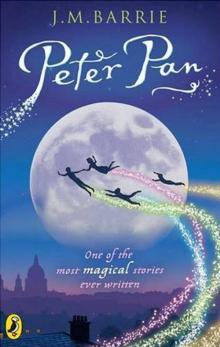 Peter Pan
Peter Pan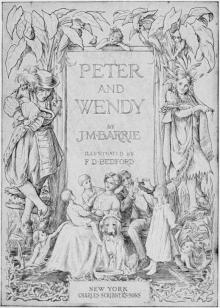 Peter and Wendy
Peter and Wendy Peter Pan in Kensington Gardens
Peter Pan in Kensington Gardens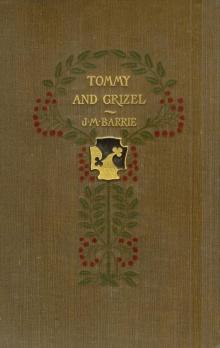 Tommy and Grizel
Tommy and Grizel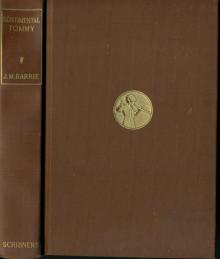 Sentimental Tommy
Sentimental Tommy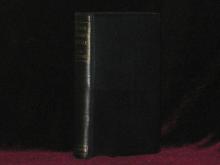 When a Man's Single: A Tale of Literary Life
When a Man's Single: A Tale of Literary Life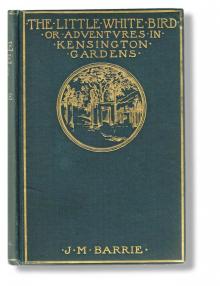 The Little White Bird; Or, Adventures in Kensington Gardens
The Little White Bird; Or, Adventures in Kensington Gardens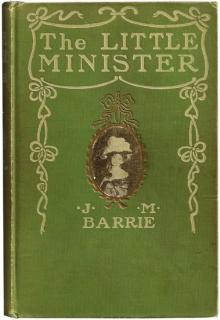 The Little Minister
The Little Minister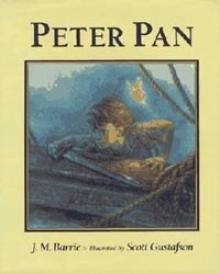 Peter Pan (peter pan)
Peter Pan (peter pan)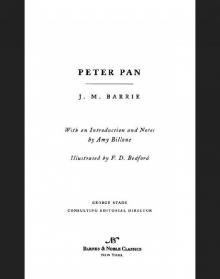 Peter Pan (Barnes & Noble Classics Series)
Peter Pan (Barnes & Noble Classics Series)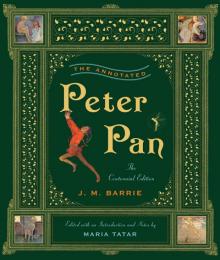 The Annotated Peter Pan (The Centennial Edition) (The Annotated Books)
The Annotated Peter Pan (The Centennial Edition) (The Annotated Books)